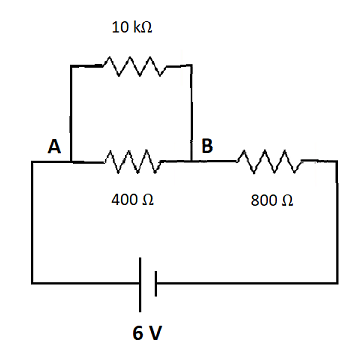
Two resistors 400 Ω and 800 Ω are connected in series across a 6 V battery. The potential difference measured by a voltmeter of 10 k Ω across 400 Ω resistors is close to:
A. 2.05 V
B. 2 V
C. 1.95 V
D. 1.8 V
Answer
220.2k+ views
Hint:In the series combination of resistance, the current is same for each resistor. A resistor is known to be connected in series if same amount of current flows through the resistors. We can determine the potential difference of the circuit by using ohm’s law.
Formula used
By ohm’s law,
$V=IR$
Where V is voltage, I is current and R is resistance.
Resistors in series,
\[\begin{array}{l}{R_s} = {R_1} + {R_2}....\\{\rm{ }}\end{array}\]
Resistors in series,
\[\dfrac{1}{{{R_p}}} = \dfrac{1}{{{R_1}}} + \dfrac{1}{{{R_2}}}....\]
Complete step by step solution:
To calculate the effective resistance of the circuit as:

Image:Circuit diagram
As 400 Ω and 10 k Ω are connected in parallel, thus resistance along AB will be,
Let \[{R_1} = 400\Omega \] and \[{R_2} = 10k\Omega = 1000\Omega \] are two resistance connected in parallel as shown in figure, then by using formula of parallel combination of resistance,
\[\dfrac{1}{{{R_p}}} = \dfrac{1}{{{R_1}}} + \dfrac{1}{{{R_2}}}\\ \Rightarrow \dfrac{1}{{{R_p}}} {\rm{ = }}\dfrac{1}{{400}} + \dfrac{1}{{1000}}\\ \Rightarrow \dfrac{1}{{{R_p}}} {\rm{ = }}\dfrac{{400 \times 1000}}{{400 + 1000}}\\ \Rightarrow {\rm{ }}{{\rm{R}}_p}{\rm{ = }}\dfrac{{5000}}{{13}}\Omega \]
Now this resistance is connected with the given resistance \[{R_3} = \] 800 Ω as shown in figure, then by using formula of series combination of resistance,
\[{R_s} = {R_p} + {R_3}\\ \Rightarrow {R_s}{\rm{ = }}\dfrac{{5000}}{{13}} + 800\\ \Rightarrow {R_s}{\rm{ = }}\dfrac{{15400}}{{13}}\Omega \]
To find current after connecting a battery of 6 V,
As, \[I = \dfrac{V}{R} = \dfrac{6}{{\dfrac{{15400}}{{13}}}}\]
\[I= \dfrac{{39}}{{7700}}A\]
As we know
\[V = IR\\ \Rightarrow V{\rm{ = }}\dfrac{{39}}{{7700}} \times \dfrac{{5000}}{{13}}\\ \therefore V{\rm{ = 1}}{\rm{.95 V}}\]
Therefore the potential difference measured by a voltmeter of 10 k Ω across 400 Ω resistors is close to 1.95 V.
Hence, option C is the correct answer
Note:A resistor is defined as a passive two terminal electrical component that implements electrical resistance as a circuit element. It reduces the flow of current and lower voltage levels within the circuits.
Formula used
By ohm’s law,
$V=IR$
Where V is voltage, I is current and R is resistance.
Resistors in series,
\[\begin{array}{l}{R_s} = {R_1} + {R_2}....\\{\rm{ }}\end{array}\]
Resistors in series,
\[\dfrac{1}{{{R_p}}} = \dfrac{1}{{{R_1}}} + \dfrac{1}{{{R_2}}}....\]
Complete step by step solution:
To calculate the effective resistance of the circuit as:

Image:Circuit diagram
As 400 Ω and 10 k Ω are connected in parallel, thus resistance along AB will be,
Let \[{R_1} = 400\Omega \] and \[{R_2} = 10k\Omega = 1000\Omega \] are two resistance connected in parallel as shown in figure, then by using formula of parallel combination of resistance,
\[\dfrac{1}{{{R_p}}} = \dfrac{1}{{{R_1}}} + \dfrac{1}{{{R_2}}}\\ \Rightarrow \dfrac{1}{{{R_p}}} {\rm{ = }}\dfrac{1}{{400}} + \dfrac{1}{{1000}}\\ \Rightarrow \dfrac{1}{{{R_p}}} {\rm{ = }}\dfrac{{400 \times 1000}}{{400 + 1000}}\\ \Rightarrow {\rm{ }}{{\rm{R}}_p}{\rm{ = }}\dfrac{{5000}}{{13}}\Omega \]
Now this resistance is connected with the given resistance \[{R_3} = \] 800 Ω as shown in figure, then by using formula of series combination of resistance,
\[{R_s} = {R_p} + {R_3}\\ \Rightarrow {R_s}{\rm{ = }}\dfrac{{5000}}{{13}} + 800\\ \Rightarrow {R_s}{\rm{ = }}\dfrac{{15400}}{{13}}\Omega \]
To find current after connecting a battery of 6 V,
As, \[I = \dfrac{V}{R} = \dfrac{6}{{\dfrac{{15400}}{{13}}}}\]
\[I= \dfrac{{39}}{{7700}}A\]
As we know
\[V = IR\\ \Rightarrow V{\rm{ = }}\dfrac{{39}}{{7700}} \times \dfrac{{5000}}{{13}}\\ \therefore V{\rm{ = 1}}{\rm{.95 V}}\]
Therefore the potential difference measured by a voltmeter of 10 k Ω across 400 Ω resistors is close to 1.95 V.
Hence, option C is the correct answer
Note:A resistor is defined as a passive two terminal electrical component that implements electrical resistance as a circuit element. It reduces the flow of current and lower voltage levels within the circuits.
Recently Updated Pages
Electricity and Magnetism Explained: Key Concepts & Applications

JEE Energetics Important Concepts and Tips for Exam Preparation

JEE Isolation, Preparation and Properties of Non-metals Important Concepts and Tips for Exam Preparation

JEE Main 2021 July 25 Shift 1 Question Paper with Answer Key

JEE Main 2021 July 22 Shift 2 Question Paper with Answer Key

States of Matter Chapter For JEE Main Chemistry

Trending doubts
JEE Main 2026: Application Form Open, Exam Dates, Syllabus, Eligibility & Question Papers

Understanding Uniform Acceleration in Physics

Derivation of Equation of Trajectory Explained for Students

Hybridisation in Chemistry – Concept, Types & Applications

Understanding the Angle of Deviation in a Prism

Understanding Atomic Structure for Beginners

Other Pages
JEE Advanced Marks vs Ranks 2025: Understanding Category-wise Qualifying Marks and Previous Year Cut-offs

Dual Nature of Radiation and Matter Class 12 Physics Chapter 11 CBSE Notes - 2025-26

How to Convert a Galvanometer into an Ammeter or Voltmeter

Understanding Centrifugal Force in Physics

JEE Main Marking Scheme 2026- Paper-Wise Marks Distribution and Negative Marking Details

Degree of Dissociation: Meaning, Formula, Calculation & Uses




